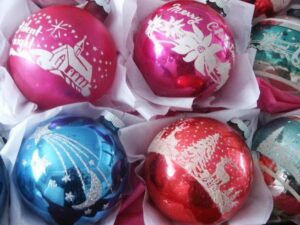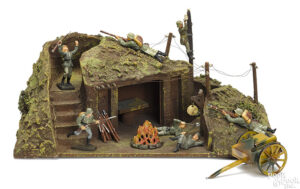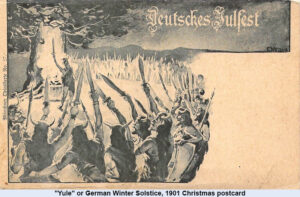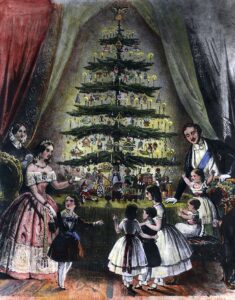An expertise in Material Culture sure comes with problems this time of year. My clients expect me to love the holidays, which are centered around STUFF. I enjoy the history of objects related to Christmas, but not the tradition of tons of stuff. The National Retail Federation estimates that Americans will spend between $942-$960 billion during this 2022 holiday season. Moreover, Christmas wasn’t really about STUFF until the mid-19th century.
Commercialization of Christmas
 The commercialization of Christmas became a tradition in and of itself in the 1800s. In 1890, Woolworth’s discovered that blown glass ornaments imported from Germany sold WELL. That year they sold MANY, giving birth to the tradition of decorating a tree with glass ornaments in the US. Tinsel from France also sold well. Woolworth’s made 25 million in December of 1890. The heyday of all commercial blown glass ornaments from Germany was 1950. That year broke the bank for one German glassblower, Max Eckhardt, who sold Woolworth’s his boxed glass ornaments called SHINY BRITE. If your grandmother keeps old ornaments in one of those segmented boxes, you’ll see the moniker ”Shiny Brite.”
The commercialization of Christmas became a tradition in and of itself in the 1800s. In 1890, Woolworth’s discovered that blown glass ornaments imported from Germany sold WELL. That year they sold MANY, giving birth to the tradition of decorating a tree with glass ornaments in the US. Tinsel from France also sold well. Woolworth’s made 25 million in December of 1890. The heyday of all commercial blown glass ornaments from Germany was 1950. That year broke the bank for one German glassblower, Max Eckhardt, who sold Woolworth’s his boxed glass ornaments called SHINY BRITE. If your grandmother keeps old ornaments in one of those segmented boxes, you’ll see the moniker ”Shiny Brite.”
Now we know where ornaments came from in 1950 (Woolworth’s), but do we know what goes under the Midcentury tree? Well, let me give you a few suggestions. I discovered a wonderful book by Sarah Archer, Midcentury Christmas (Countryman Press, 2016). It lists my favorite toys: gender specific, dangerous, colorful, and dynamic.
1960s toys: little versions of the adult world
 We saw models of domestic appliances, mini kitchens, dollhouse furniture, and small porcelain tea sets for girls. For boys, chemistry sets, war machines and tanks, telescopes, and trains. Think of it as House Beautiful meets Scientific American. Daughters seen as House Beautiful and sons seen as Scientific American, of course.
We saw models of domestic appliances, mini kitchens, dollhouse furniture, and small porcelain tea sets for girls. For boys, chemistry sets, war machines and tanks, telescopes, and trains. Think of it as House Beautiful meets Scientific American. Daughters seen as House Beautiful and sons seen as Scientific American, of course.
 An advertising trend in the early to mid-1960s said the best Christmas present for your ‘wife’ might be an appliance. In fact, I remember my mother becoming confused when dad gave her a dishwasher. Other ads of the time said Santa wants to give typewriters or washing machines. A great ad from 1958 said to ignore traditional dining room objects and buy foldable metal furniture for the holidays. Remember that card table laid out with punch and cookies in the “family” room?
An advertising trend in the early to mid-1960s said the best Christmas present for your ‘wife’ might be an appliance. In fact, I remember my mother becoming confused when dad gave her a dishwasher. Other ads of the time said Santa wants to give typewriters or washing machines. A great ad from 1958 said to ignore traditional dining room objects and buy foldable metal furniture for the holidays. Remember that card table laid out with punch and cookies in the “family” room?
 To top this off, what about aluminum trees? Reynolds Metal Corp made many of these in the 1960s. Americans considered them futuristic conveniences, like appliances., because they didn’t shed, could be stored till next year, and could amplify colored lights. If you find one from the 1960s, in good shape, they’re big money today. I picture an aluminum tree with blown glass vintage ornaments, and under that tree, wrapped up, Silly Putty, Slinky, Etch a Sketch (Ohio Art Co 1960), and a spirograph, and mom crying when the dishwasher is delivered.
To top this off, what about aluminum trees? Reynolds Metal Corp made many of these in the 1960s. Americans considered them futuristic conveniences, like appliances., because they didn’t shed, could be stored till next year, and could amplify colored lights. If you find one from the 1960s, in good shape, they’re big money today. I picture an aluminum tree with blown glass vintage ornaments, and under that tree, wrapped up, Silly Putty, Slinky, Etch a Sketch (Ohio Art Co 1960), and a spirograph, and mom crying when the dishwasher is delivered.
That was 1960. Now I’ll go back to the 16th century, and Christmas STUFF of the 1700s.
Let’s start with ornaments:
 16th century Germany celebrated Winter Solstice along with the birth of Christ. Folks cut down an evergreen to give them hope during the winter for the rebirth of LIFE. For 200 years German peasants brought in an evergreen, or a bough or two, and decorated it with symbols of life: birds, fruits, and berries.
16th century Germany celebrated Winter Solstice along with the birth of Christ. Folks cut down an evergreen to give them hope during the winter for the rebirth of LIFE. For 200 years German peasants brought in an evergreen, or a bough or two, and decorated it with symbols of life: birds, fruits, and berries.
This Germanic tradition of bringing a tree that wouldn’t die into the home goes back to Egyptian culture. Roman housewives decorated tops of walls with evergreen boughs, Druid and Viking cultures did as well. Hence we have the expression the Tree of Life….
Whatever culture brought the evergreen tree in the house, they didn’t hang more than fruits and berries on it. Until, 1847 in a town in Germany called Lauscha, when a glassblower named Hans Greiner made imitation berries and fruits that dangled on the tree. He called these ‘Baubles’ in English, ‘Kugels’ in German. Other glassmakers noted their popularity, so Japanese and Eastern European glassblowers made tree ornaments for import.
 In 1850, American newspapers picked up the chromolithograph of Queen Victoria, with her German born Prince Albert, and their many children around an evergreen tree. Well, that became the fashionable thing to do in America in 1850. The wealthy hauled in cut evergreen trees. Ironically, Christmas trees were considered a European tradition, and in fact many early American religious leaders counselled against the tree as a pagan symbol. Queen Victoria brought America its first trees, with the exception of small German-American villages of the early 1800s.
In 1850, American newspapers picked up the chromolithograph of Queen Victoria, with her German born Prince Albert, and their many children around an evergreen tree. Well, that became the fashionable thing to do in America in 1850. The wealthy hauled in cut evergreen trees. Ironically, Christmas trees were considered a European tradition, and in fact many early American religious leaders counselled against the tree as a pagan symbol. Queen Victoria brought America its first trees, with the exception of small German-American villages of the early 1800s.
First invented with silver leaf in Germany in 1610, tinsel has hung on these European trees for many years. In the 1920s tinsel was made from aluminum, and by the1940s lead, which became illegal in 1972. Now tinsel is PLASTIC, along with just about everything else.